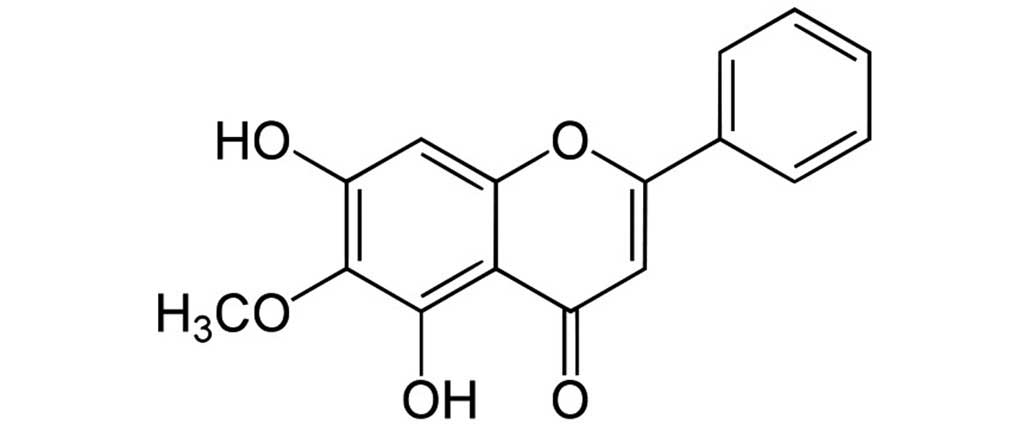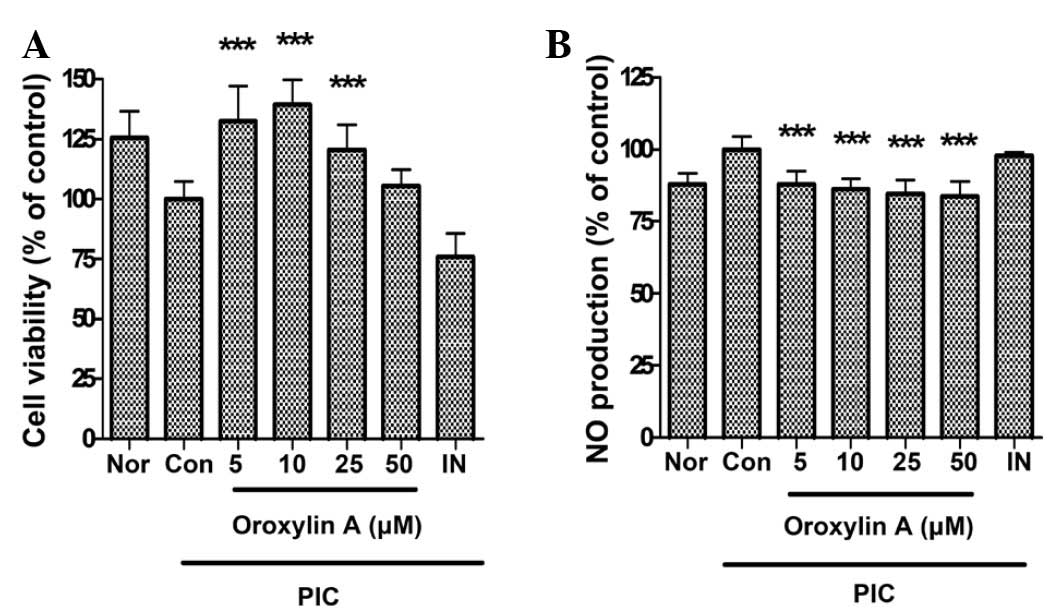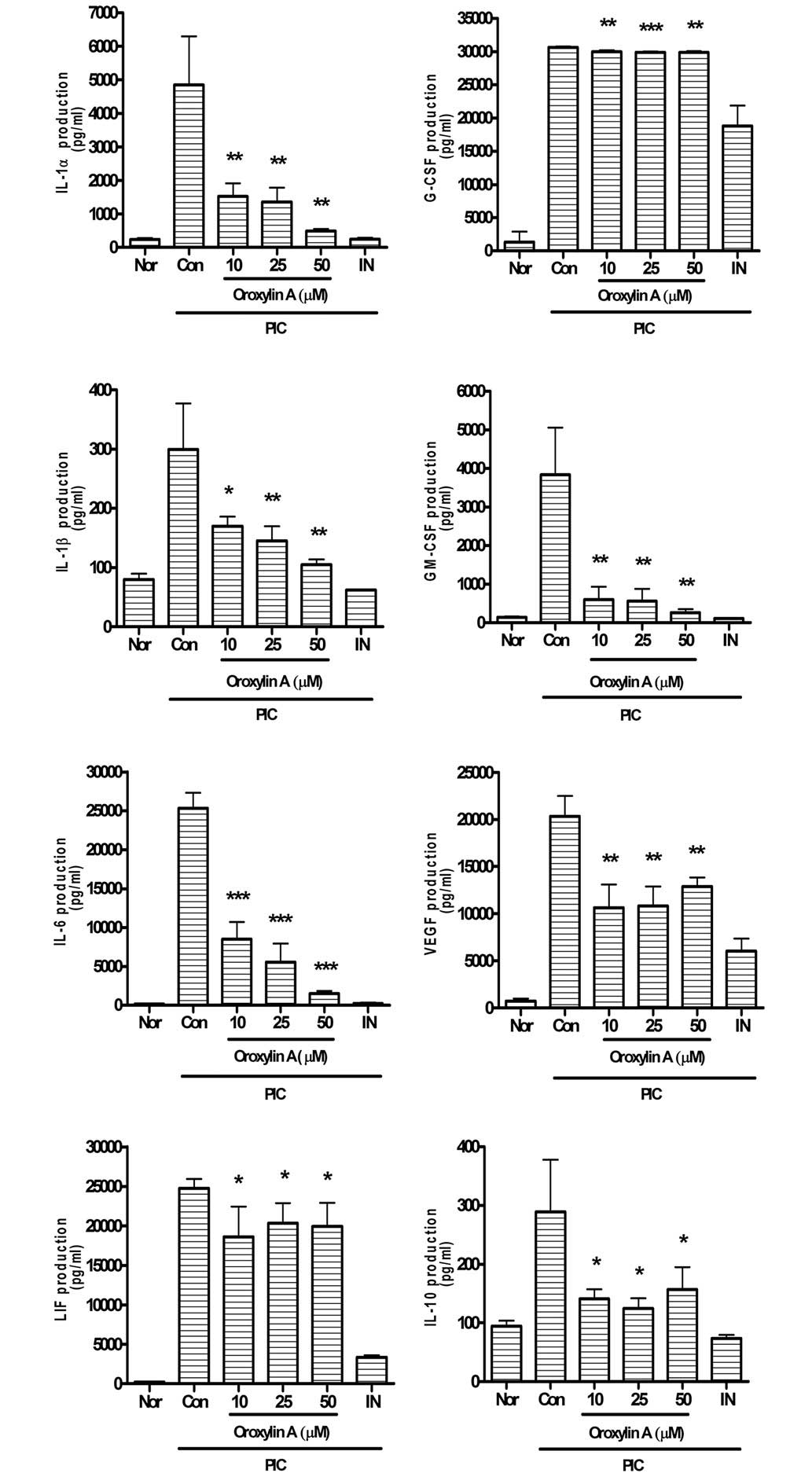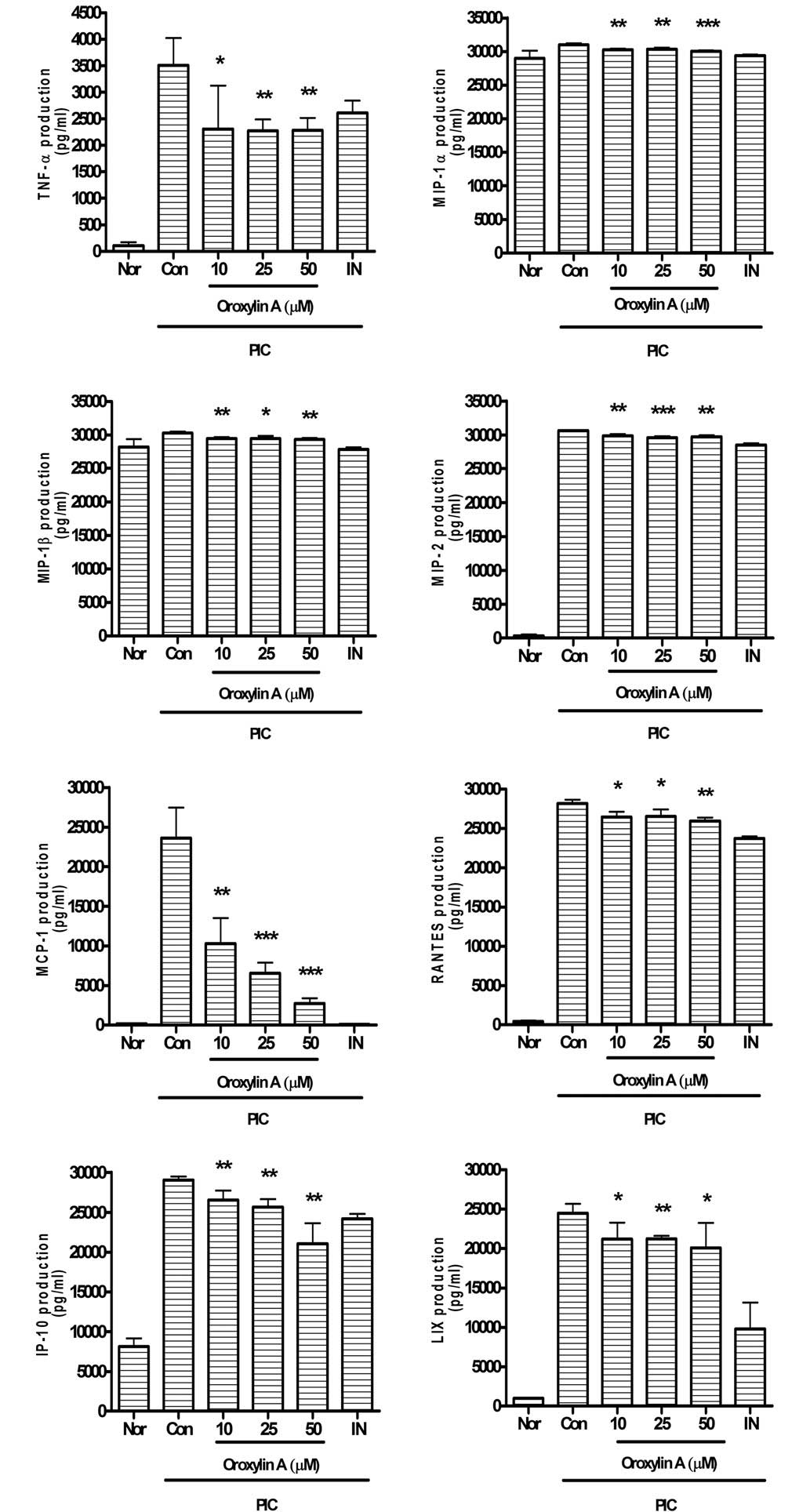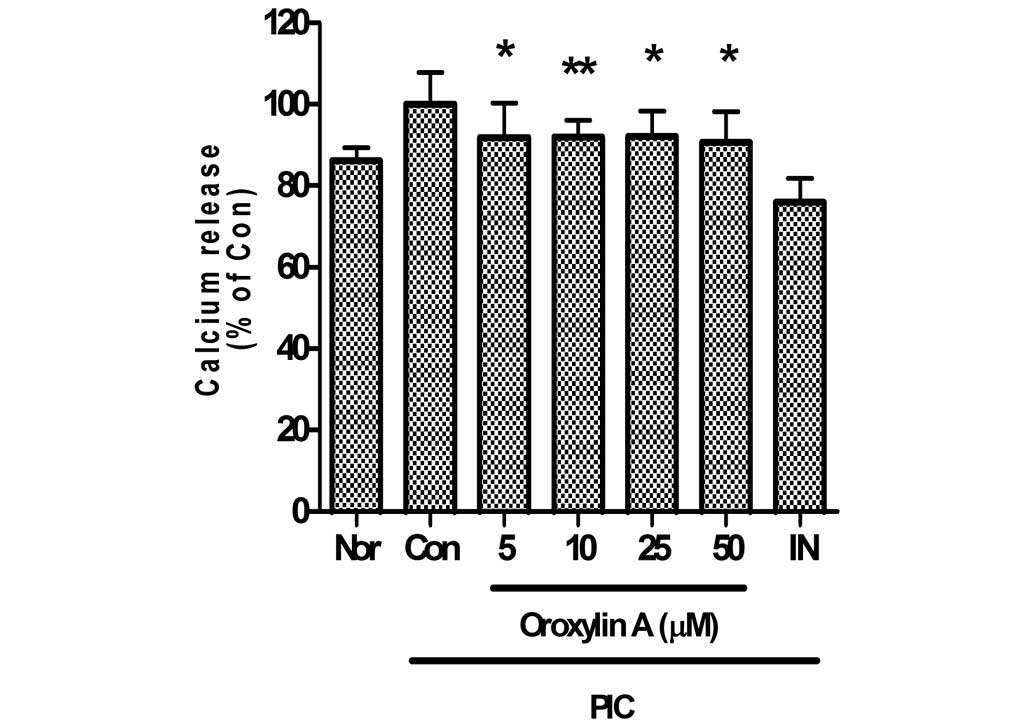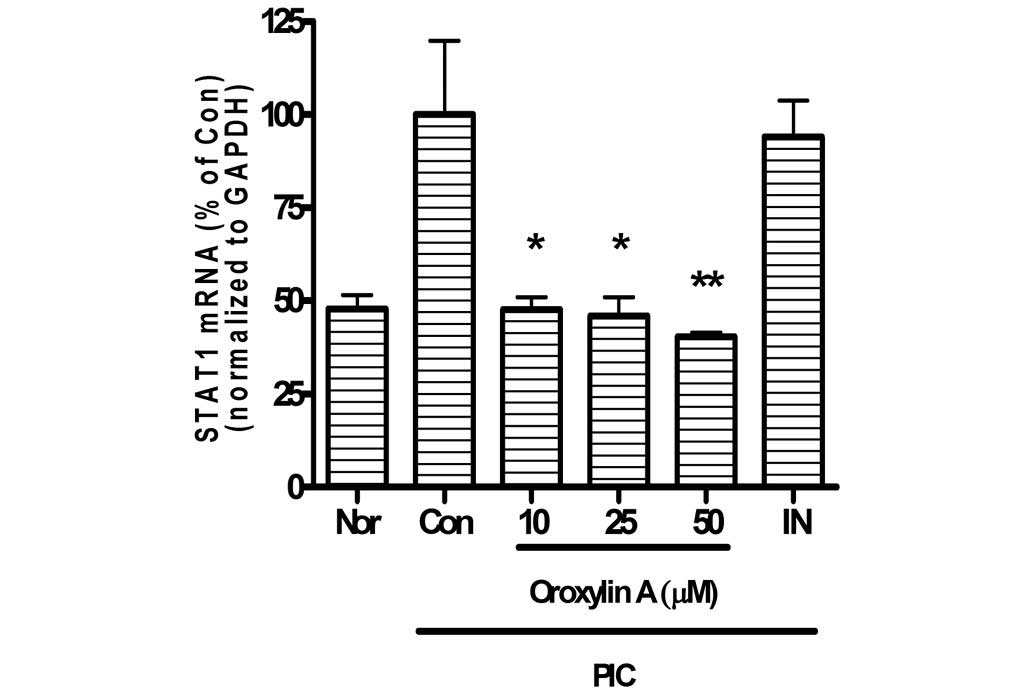Anti-inflammatory effects of oroxylin A on RAW 264.7 mouse macrophages induced with polyinosinic-polycytidylic acid
- Authors:
- Published online on: May 9, 2016 https://doi.org/10.3892/etm.2016.3320
- Pages: 151-156
-
Copyright: © Lee et al. This is an open access article distributed under the terms of Creative Commons Attribution License.
Abstract
Introduction
The innate immune system and inflammation are crucial for protecting host organisms from invasive pathogens and injurious stimuli (1). Gao and Hong (1) reported that inflammation is part of the non-specific immune response that occurs in reaction to harmful stimuli, such as pathogenic microbes, damaged cells, irritants or bodily injury, with a primary aim of neutralizing infectious agents and initiating repair to damaged tissue. Conversely, uncontrolled inflammatory responses lead to the development of acute or chronic inflammatory diseases (1).
Macrophages are inflammatory cells implicated in the initiation of inflammatory responses, and have critical roles in the pathogenesis of numerous inflammatory disease processes by secreting various proinflammatory mediators, including nitric oxide (NO) and proinflammatory cytokines (2). Therefore, the modulation of macrophage-mediated inflammatory responses may be useful in the development of novel therapeutic approaches against these inflammatory diseases (3). Medina et al (4) have reported that macrophages have an important role in inflammatory disease via the release of factors such as NO, reactive oxygen species, inflammatory cytokines, chemokines, growth factors and prostaglandin mediators involved in the immune response.
However, Ulevitch and Tobias (5) have reported that excessive and uncontrolled production of inflammatory mediators such as NO and cytokines may lead to serious systemic complications such as microcirculatory dysfunction, tissue damage and septic shock, which may result in mortality.
Carrithers (6) reported that innate immune responses mediated by mononuclear phagocytes represent the initial host response to acute viral infection and pattern recognition receptors recognize viral nucleic acid and localized injury signals to initiate proinflammatory responses and activation of adaptive immunity.
Oroxylin A (5,7-dihydroxy-6-methoxy-2-phenylchromen-4-one; Baicalein 6-methyl ether; Fig. 1) is an active flavonoid compound isolated from Scutellaria radix, which has been used to treat pulmonary infection traditionally in Korea, China and Japan (7,8).
Tran et al (9) have reported that oroxylin A is known to have dopamine reuptake inhibitor activity and an inhibitory effect on nuclear factor-κB activation. Singh and Kakkar (10) have reported that oroxylin A enhanced lipolysis and decreased Akt phosphorylation in mature adipocytes, suggesting that oroxylin A may exert its anti-obesity effect by affecting the adipocyte life cycle at critical points of differentiation and maturity. Akinyi et al (11) have reported that oroxylin A could significantly reduce coronary perfusion pressure in a Langendorff preparation assay of isolated rat heart tissue.
However, the effects of oroxylin A on virus-induced macrophages have not been fully reported.
Double stranded (ds)RNA, which accumulates at various stages of viral replication, stimulates macrophages to produce inflammatory mediators (12). Polyinosinic-polycytidylic acid (PIC) is a synthetic analog of dsRNA. Like other pathogenic endotoxins, dsRNA activates macrophages to provoke the production of numerous inflammatory mediators, including NO, cytokines, chemokines and growth factors, resulting in acute or chronic inflammation (12).
The aim of the present study was to investigate the inhibitory effects of oroxylin A on PIC-induced inflammation using RAW 264.7 mouse macrophages. The impact of oroxylin A was evaluated on a range of variables, including the production of NO, interleukin (IL)-1α, IL-1β, IL-6, IL-10, interferon gamma-inducible protein 10 (IP-10), monocyte chemoattractant protein 1 (MCP-1), granulocyte colony-stimulating factor (G-CSF), granulocyte macrophage-CSF (GM-CSF), leukemia inhibitory factor (LIF; IL-6 class cytokine), lipopolysaccharide-induced CXC chemokine (LIX), macrophage inflammatory protein (MIP)-1α, MIP-1β, MIP-2, Regulated on Activation, Normal T Expressed and Secreted (RANTES), tumor necrosis factor (TNF)-α and vascular endothelial growth factor (VEGF), as well as calcium release and mRNA expression of signal transducer and activated transcription 1 (STAT1) in PIC-induced RAW 264.7 mouse macrophages.
Materials and methods
Materials
Dulbecco's modified Eagle's medium (DMEM), fetal bovine serum (FBS), penicillin, streptomycin, phosphate-buffered saline (PBS) and trypsin were purchased from Gibco (Thermo Fisher Scientific, Inc., Grand Island, NY, USA). Oroxylin A, indomethacin, Griess Reaction and MTT Assay kits were purchased from Sigma-Aldrich (St. Louis, MO, USA).
Cell viability assay
RAW 264.7 mouse macrophages were obtained from the Korea Cell Line Bank (Seoul, Korea). RAW 264.7 cells (2×104/well) were seeded into 96-well plates and cultured in DMEM supplemented with 10% FBS, 100 U/ml penicillin and 100 µg/ml streptomycin at 37°C in a 5% CO2 humidified incubator. Cell viability was evaluated using an MTT Assay kit. The macrophages were divided into four groups, as follows: i) The normal group (Nor), which was treated with media only; ii) the control group (Con), which was treated with PIC; iii) the oroxylin A group, which was treated with PIC and various concentrations of oroxylin A; and iv) the indomethacin group (IN), which was treated with PIC and indomethacin. Indomethacin was used as a positive control.
Quantification of NO production
NO concentration in culture medium was determined using the Griess Reaction kit. Briefly, after incubation of the cells with PIC and/or oroxylin A for 24 h, 100 µl supernatant from each well was mixed with 100 µl Griess reagent in 96-well plates. After an incubation of 15 min at room temperature, the optical density was determined at 540 nm using a microplate reader (Bio-Rad Laboratories, Inc., Hercules, CA, USA).
Multiplex bead-based cytokine assay
After 24 h treatment with PIC and/or oroxylin A, the levels of various cytokines released from treated cells were measured in cell culture supernatants using a Luminex assay based on xMAP technology. This assay was performed using Milliplex kits (EMD Millipore, Billerica, MA, USA) and a Bio-Plex 200 suspension array system (Bio-Rad Laboratories, Inc.) as described previously (13,14). Standard curves for each cytokine were generated using the kit-supplied reference cytokine samples.
Intracellular calcium assay
After RAW 264.7 cells (2×104/well) were seeded in wells of 96-well plates, PIC and/or oroxylin A were added to the culture medium and incubation was conducted for 24 h at 37°C. Thereafter, the medium was removed and cells were incubated with 100 µl Fluo-4 dye loading solution (Molecular Probes; Thermo Fisher Scientific, Inc., Eugene, OR, USA) for 30 min at 37°C. Following incubation, the fluorescence intensity of each well was determined spectrofluorometrically (Dynex Technologies, West Sussex, UK) with excitation and emission filters of 485 and 535 nm, respectively.
STAT1 mRNA expression
At the end of 24 h incubation with PIC and/or oroxylin A, RAW 264.7 mouse macrophages were lysed using lysis buffer (Bio-Rad Laboratories, Inc.). To simultaneously quantify multiple RNA targets directly from cell lysate, a QuantiGene Plex 2.0 Reagent System (Panomics, Inc., Redwood City, CA, USA) based on branched DNA signal amplification technology with xMAP beads was used according to manufacturer's instructions (15) and mRNA expression of STAT1 (GenBank no. NM_009283) was determined. Data were normalized against the control, GAPDH (GenBank no. NM_001001303).
Statistical analysis
The results shown are summarized from three independent experiments and represent the mean ± standard deviation. Differences were evaluated using Student's t-test with SPSS 11.0 software (SPSS, Inc., Chicago, IL, USA). P<0.05 was considered to indicate a statistically significant difference.
Results
Effect of oroxylin A on cell viability
In this study, oroxylin A at a concentration of 50 µM restored the cell viability in PIC-induced RAW 264.7 mouse macrophages. Cell viabilities in PIC-induced RAW 264.7 mouse macrophages incubated with oroxylin A at concentrations of 5, 10, 25 and 50 µM for 24 h were 132.46±14.56, 139.4±10.28, 120.58±10.32 and 105.38±6.76% of the control (50 µg/ml PIC alone) value, respectively. Based on this result, oroxylin A concentrations of up to 50 µM were selected for subsequent experiments, as the cytotoxicity of oroxylin A was not obvious (Fig. 2A).
Effect of oroxylin A on NO production
The results showed that oroxylin A significantly inhibits overproduction of NO in PIC-induced RAW 264.7 mouse macrophages (P<0.001) (Fig. 2B). The production of NO in PIC-induced RAW 264.7 mouse macrophages incubated with oroxylin A at concentrations of 5, 10, 25 and 50 µM for 24 h were 87.84±4.47, 86.18±3.66, 84.41±4.89 and 83.68±5.28% of the control value (50 µg/ml PIC alone), respectively.
Effect of oroxylin A on cytokine production
Oroxylin A significantly reduces the overproduction of IL-1α, G-CSF, IL-1β, GM-CSF, IL-6, VEGF, LIF, IL-10 (Fig. 3), TNF-α, MIP-1α, MIP-1β, MIP-2, MCP-1, RANTES, IP-10 and LIX (Fig. 4) in PIC-induced RAW 264.7 mouse macrophages.
Effect of oroxylin A on intracellular calcium release
In the present study, oroxylin A significantly inhibited calcium release in PIC-induced RAW 264.7 mouse macrophages (Fig. 5). Calcium release in PIC-induced RAW 264.7 mouse macrophages incubated with oroxylin A at concentrations of 5, 10, 25 and 50 µM for 24 h were 91.87±8.47, 91.99±4.1, 92.07±6.25 and 90.61±7.52% of the control (50 µg/ml PIC alone), respectively.
Effects of oroxylin A on expression of STAT1 mRNA
In the present study, oroxylin A significantly reduced STAT1 mRNA expression of PIC-activated mouse macrophages in a dose-dependent manner (Fig. 6). Expression levels of STAT1 mRNA in PIC-induced RAW 264.7 mouse macrophages incubated with oroxylin A at concentrations of 10, 25 and 50 µM for 24 h were 47.7±3.33, 46.02±4.98 and 40.34±1.12% of the control value (50 µg/ml PIC alone), respectively.
Discussion
According to a previous report by Tran et al, oroxylin A has a dopamine reuptake inhibitor activity, and the inhibitory effect of nuclear factor-κB activation (9). Singh and Kakkar (10) reported that oroxylin A enhanced lipolysis and decreased Akt phosphorylation in mature adipocytes, suggesting that oroxylin A may exert its anti-obesity effect by influencing adipocyte life cycle at critical points of differentiation and maturity. Akinyi et al (11) have reported that oroxylin A may significantly lower the coronary perfusion pressure in a Langendorff preparation assay of isolated rat heart tissue. Previously, Qiao et al (16) reported that oroxylin A induces apoptosis by regulating uncoupling protein 2 in human colon cancer cells. Ye et al (17) reported that regulating inflammation could be an important measure for the effective treatment of cancer; oroxylin A inhibits lipopolysaccharide-induced mRNA and protein expression of cyclooxygenase-2 and nitric oxide synthase in RAW 264.7 cells. Zhou et al (18) reported that oroxylin A attenuated ovalbumin-induced lung histopathologic changes and airway hyperresponsiveness, and reduced the number of inflammatory cells. Hui et al (19) reported that production of IL-6 constitutes the primary cause of mortality in patients with retinoic acid syndrome; oroxylin A possesses abilities of inhibiting the all-trans retinoic acid-induced IL-6 production in leukemia cell lines, which may provide a therapeutic strategy for retinoic acid syndrome. Wang et al (20) reported that oroxylin A improves the sensitivity of multidrug-resistant leukemic cells by increasing apoptosis in leukemic cells and decreasing the expression of chemokine receptor 4, and may serve as a potential agent for chronic myeloid leukemia. However, the effects of oroxylin A on virus-induced macrophages have not been fully elucidated.
Innate immunity and inflammation are crucial for protecting the host against various pathogens, including bacteria, viruses and fungi (2). Mosser and Edwards (21) have reported that macrophages, which are a type of white blood cell that engulf and digest cellular debris, foreign substances, microbes and cancer cells in a process called phagocytosis, play a critical role in innate immunity, and also help initiate adaptive immunity by recruiting other immune cells such as lymphocytes. Canna et al (22) have reported that inflammasomes are innate immune sensors that respond to pathogen- and damage-associated signals with caspase-1 activation, IL-1β and IL-18 secretion, and macrophage pyroptosis, a proinflammatory and lytic mode of cell death.
In the case of viral infection, dsRNA from pathogenic viruses is a strong initiator of inflammation and stimulates macrophages to produce inflammatory mediators including NO, cytokines, chemokines and growth factors in immune responses and organ injuries (12).
Unregulated inflammation is an underlying component of various diseases, such as sepsis, cardiovascular disease, diabetes and other chronic inflammatory diseases (23). Furthermore, Ulloa and Tracey (24) have reported that viral and bacterial infections contribute to the pathogenesis of severe sepsis, which is characterized by an overwhelming production of NO and proinflammatory cytokines, such as IL-1, IL-6 and TNF-α. Riedemann et al (25) have reported that the excessive production of IL-1 and IL-6 may be more dangerous than the original stimulus, causing capillary leakage, tissue injury and lethal organ failure, although these cytokines trigger a beneficial inflammatory response that promotes local coagulation to confine tissue damage.
Srivastava et al (26) have reported that various chemokines, such as MCP-1, IP-10, M-CSF, G-CSF and GM-CSF, are increased in bronchoalveolar fluid during lung inflammation. Wareing et al (27) have reported that the expression level of MIP-1α, MIP-1β, MIP-2 and RANTES is increased in lung tissue of influenza infection.
By contrast, Sakaguchi and Wing (28) reported that superfluous or misguided human immune responses may lead to harmful outcomes, as associated with autoimmune disease, chronic inflammation and allergies. Ballara et al (29) have reported that the proangiogenic cytokine VEGF in the persistence of inflammatory arthritis supports the hypothesis that expansion of the synovial vasculature is important for the development of joint destruction in rheumatoid arthritis. Recently, Reddy et al (30) reported that LIX expression was induced in arthritis and periodontal disease. Schon and Boehncke (31) have reported that the central role of cytokines and their functional interaction with adhesion molecules in the recruitment of tissue-specific lymphocytes has been clearly shown, primarily involving LIF (IL-6 class cytokine) and IL-10 in psoriasis (a chronic immune-mediated skin disease). Previously, Dace et al (32) reported that IL-10, although traditionally considered to be an anti-inflammatory cytokine that modulates the function of adaptive immune-related cells, has also been implicated in promoting abnormal angiogenesis in the eye and in the pathobiology of autoimmune diseases such as lupus and encephalomyelitis.
In the present study, the data indicate that oroxylin A has inhibitory effects against the viral inflammation associated with macrophage inflammasomes.
Cuschieri and Maier (33) have reported that pathogenic oxidative stress with infection results in macrophage reprogramming with a transient increase in intracellular calcium via the lipid membrane dissociation of the calcium-bound protein annexin VI; this increased cytosolic calcium, in turn, results in the activation of calcium-dependent kinases, leading to enhanced proinflammatory activation. Furthermore, Timmins et al (34) have reported that the endoplasmic reticulum (ER) calcium stores are reduced in oxidative stress and intracellular calcium concentration is increased, resulting in ER stress-mediated STAT1 activation. In the present study, oroxylin A inhibited the calcium release and STAT1 mRNA expression in PIC-induced RAW 264.7 mouse macrophages. Thus, it is possible that oroxylin A downregulates the excessive production of inflammatory mediators in pathogenic toxicant-induced macrophages through the calcium-STAT pathway.
However, whether intracellular calcium concentration is increased via the calcium-bound membrane protein mobilization or release of calcium from ER could not be confirmed in this study.
Although the precise mechanism underlying the regulation of the anti-inflammatory activity of oroxylin A are not yet known, the current study demonstrates that oroxylin A has anti-inflammatory effects associated with its inhibition of NO, IL-1α, IL-1β, IL-6, IL-10, IP-10, G-CSF, GM-CSF, LIF (IL-6 class cytokine), LIX, MCP-1, MIP-1α, MIP-1β, MIP-2, RANTES, TNF-α and VEGF in PIC-induced macrophages via calcium-STAT pathway. Actual effect of oroxylin A on acute and chronic inflammatory diseases requires further study.
Acknowledgements
The authors thank Dr Young-Jin Kim and Ms. Hyun Joo Kim (College of Korean Medicine, Gachon University) for their technical assistance.
References
|
Gao HM and Hong JS: Why neurodegenerative diseases are progressive: Uncontrolled inflammation drives disease progression. Trends Immunol. 29:357–365. 2008. View Article : Google Scholar : PubMed/NCBI | |
|
Lee JY and Park W: Anti-inflammatory effect of wogonin on RAW 264.7 mouse macrophages induced with polyinosinic-polycytidylic acid. Molecules. 20:6888–6900. 2015. View Article : Google Scholar : PubMed/NCBI | |
|
Zong Y, Sun L, Liu B, Deng YS, Zhan D, Chen YL, He Y, Liu J, Zhang ZJ, Sun J and Lu D: Resveratrol inhibits LPS-induced MAPKs activation via activation of the phosphatidylinositol 3-kinase pathway in murine RAW 264.7 macrophage cells. PLoS One. 7:e441072012. View Article : Google Scholar : PubMed/NCBI | |
|
Medina EA, Morris IR and Berton MT: Phosphatidylinositol 3-kinase activation attenuates the TLR2-mediated macrophage proinflammatory cytokine response to Francisella tularensis live vaccine strain. J Immunol. 185:7562–7572. 2010. View Article : Google Scholar : PubMed/NCBI | |
|
Ulevitch RJ and Tobias PS: Receptor-dependent mechanisms of cell stimulation by bacterial endotoxin. Annu Rev Immunol. 13:437–457. 1995. View Article : Google Scholar : PubMed/NCBI | |
|
Carrithers MD: Innate immune viral recognition: Relevance to CNS infections. Handb Clin Neurol. 123:215–223. 2014. View Article : Google Scholar : PubMed/NCBI | |
|
Kim DH, Kim S, Jeon SJ, Son KH, Lee S, Yoon BH, Cheong JH, Ko KH and Ryu JH: The effects of acute and repeated oroxylin A treatments on abeta (25-35)-induced memory impairment in mice. Neuropharmacology. 55:639–647. 2008. View Article : Google Scholar : PubMed/NCBI | |
|
Li HN, Nie FF, Liu W, Dai QS, Lu N, Qi Q, Li ZY, You QD and Guo QL: Apoptosis induction of oroxylin A in human cervical cancer HeLa cell line in vitro and in vivo. Toxicology. 257:80–85. 2009. View Article : Google Scholar : PubMed/NCBI | |
|
Tran TV, Malainer C, Schwaiger S, Hung T, Atanasov AG, Heiss EH, Dirsch VM and Stuppner H: Screening of vietnamese medicinal plants for NF-kB signaling inhibitors: Assessing the activity of flavonoids from the stem bark of Oroxylum indicum. J Ethnopharmacol. 159:36–42. 2015. View Article : Google Scholar : PubMed/NCBI | |
|
Singh J and Kakkar P: Oroxylin A, a constituent of Oroxylum indicum inhibits adipogenesis and induces apoptosis in 3T3-L1 cells. Phytomedicine. 21:1733–1741. 2014. View Article : Google Scholar : PubMed/NCBI | |
|
Akinyi M, Gao XM, Li YH, Wang BY, Liu EW, Chai LJ, JawoBah A and Fan GW: Vascular relaxation induced by Eucommiae ulmoides oliv. and its compounds oroxylin A and wogonin: Implications on their cytoprotection action. Int J Clin Exp Med. 7:3164–3180. 2014.PubMed/NCBI | |
|
Lee JY and Park W: Anti-inflammatory effect of myristicin on RAW 264.7 macrophages stimulated with polyinosinic-polycytidylic acid. Molecules. 16:7132–7142. 2011. View Article : Google Scholar : PubMed/NCBI | |
|
Yoon SB, Lee YJ, Park SK, Kim HC, Bae H, Kim HM, Ko SG, Choi HY, Oh MS and Park W: Anti-inflammatory effects of Scutellaria baicalensis water extract on LPS-activated RAW 264.7 macrophages. J Ethnopharmacol. 125:286–290. 2009. View Article : Google Scholar : PubMed/NCBI | |
|
Yuk SS, Lim EM, Lee JY, Lee YJ, Kim YS, Lee TH, Park SK, Bae H, Kim HM, Ko SG, et al: Antiinflammatory effects of Epimedium brevicornum water extract on lipopolysaccharide-activated RAW264.7 macrophages. Phytother Res. 24:1781–1787. 2010. View Article : Google Scholar : PubMed/NCBI | |
|
Flagella M, Bui S, Zheng Z, Nguyen CT, Zhang A, Pastor L, Ma Y, Yang W, Crawford KL, McMaster GK, et al: A multiplex branched DNA assay for parallel quantitative gene expression profiling. Anal Biochem. 352:50–60. 2006. View Article : Google Scholar : PubMed/NCBI | |
|
Qiao C, Wei L, Dai Q, Zhou Y, Yin Q, Li Z, Xiao Y, Guo Q and Lu N: UCP2-related mitochondrial pathway participates in oroxylin A-induced apoptosis in human colon cancer cells. J Cell Physiol. 230:1054–1063. 2015. View Article : Google Scholar : PubMed/NCBI | |
|
Ye M, Wang Q, Zhang W, Li Z, Wang Y and Hu R: Oroxylin A exerts anti-inflammatory activity on lipopolysaccharide-induced mouse macrophage via Nrf2/ARE activation. Biochem Cell Biol. 92:337–348. 2014. View Article : Google Scholar : PubMed/NCBI | |
|
Zhou DG, Diao BZ, Zhou W and Feng JL: Oroxylin A Inhibits Allergic Airway Inflammation in Ovalbumin (OVA)-Induced Asthma Murine Model. Inflammation. 39:867–872. 2016. View Article : Google Scholar : PubMed/NCBI | |
|
Hui H, Yang H, Dai Q, Wang Q, Yao J, Zhao K, Guo Q and Lu N: Oroxylin A inhibits ATRA-induced IL-6 expression involved in retinoic acid syndrome by down-regulating CHOP. Gene. 551:230–235. 2014. View Article : Google Scholar : PubMed/NCBI | |
|
Wang Y, Miao H, Li W, Yao J, Sun Y, Li Z, Zhao L and Guo Q: CXCL12/CXCR4 axis confers adriamycin resistance to human chronic myelogenous leukemia and oroxylin A improves the sensitivity of K562/ADM cells. Biochem Pharmacol. 90:212–225. 2014. View Article : Google Scholar : PubMed/NCBI | |
|
Mosser DM and Edwards JP: Exploring the full spectrum of macrophage activation. Nat Rev Immunol. 8:958–969. 2008. View Article : Google Scholar : PubMed/NCBI | |
|
Canna SW, de Jesus AA, Gouni S, Brooks SR, Marrero B, Liu Y, DiMattia MA, Zaal KJ, Sanchez GA, Kim H, et al: An activating NLRC4 inflammasome mutation causes autoinflammation with recurrent macrophage activation syndrome. Nat Genet. 46:1140–1146. 2014. View Article : Google Scholar : PubMed/NCBI | |
|
Spite M, Norling LV, Summers L, Yang R, Cooper D, Petasis NA, Flower RJ, Perretti M and Serhan CN: Resolvin D2 is a potent regulator of leukocytes and controls microbial sepsis. Nature. 461:1287–1291. 2009. View Article : Google Scholar : PubMed/NCBI | |
|
Ulloa L and Tracey KJ: The ‘cytokine profile’: A code for sepsis. Trends Mol Med. 11:56–63. 2005. View Article : Google Scholar : PubMed/NCBI | |
|
Riedemann NC, Neff TA, Guo RF, Bernacki KD, Laudes IJ, Sarma JV, Lambris JD and Ward PA: Protective effects of IL-6 blockade in sepsis are linked to reduced C5a receptor expression. J Immunol. 170:503–507. 2003. View Article : Google Scholar : PubMed/NCBI | |
|
Srivastava M, Jung S, Wilhelm J, Fink L, Bühling F, Welte T, Bohle RM, Seeger W, Lohmeyer J and Maus UA: The inflammatory versus constitutive trafficking of mononuclear phagocytes into the alveolar space of mice is associated with drastic changes in their gene expression profiles. J Immunol. 175:1884–1893. 2005. View Article : Google Scholar : PubMed/NCBI | |
|
Wareing MD, Lyon AB, Lu B, Gerard C and Sarawar SR: Chemokine expression during the development and resolution of a pulmonary leukocyte response to influenza A virus infection in mice. J Leukoc Biol. 76:886–895. 2004. View Article : Google Scholar : PubMed/NCBI | |
|
Sakaguchi S and Wing K: Immunology. damping by depletion. Science. 332:542–543. 2011. View Article : Google Scholar : PubMed/NCBI | |
|
Ballara S, Taylor PC, Reusch P, Marmé D, Feldmann M, Maini RN and Paleolog EM: Raised serum vascular endothelial growth factor levels are associated with destructive change in inflammatory arthritis. Arthritis Rheum. 44:2055–2064. 2001. View Article : Google Scholar : PubMed/NCBI | |
|
Ruddy MJ, Shen F, Smith JB, Sharma A and Gaffen SL: Interleukin-17 regulates expression of the CXC chemokine LIX/CXCL5 in osteoblasts: Implications for inflammation and neutrophil recruitment. J Leukoc Biol. 76:135–144. 2004. View Article : Google Scholar : PubMed/NCBI | |
|
Schön MP and Boehncke WH: Psoriasis. N Engl J Med. 352:1899–1912. 2005. View Article : Google Scholar : PubMed/NCBI | |
|
Dace DS, Khan AA, Stark JL, Kelly J, Cross AH and Apte RS: Interleukin-10 overexpression promotes Fas-ligand-dependent chronic macrophage-mediated demyelinating polyneuropathy. PLoS One. 4:e71212009. View Article : Google Scholar : PubMed/NCBI | |
|
Cuschieri J and Maier RV: Oxidative stress, lipid rafts, and macrophage reprogramming. Antioxid Redox Signal. 9:1485–1497. 2007. View Article : Google Scholar : PubMed/NCBI | |
|
Timmins JM, Ozcan L, Seimon TA, Li G, Malagelada C, Backs J, Backs T, Bassel-Duby R, Olson EN, Anderson ME and Tabas I: Calcium/calmodulin-dependent protein kinase II links ER stress with Fas and mitochondrial apoptosis pathways. J Clin Invest. 119:2925–2941. 2009. View Article : Google Scholar : PubMed/NCBI |



